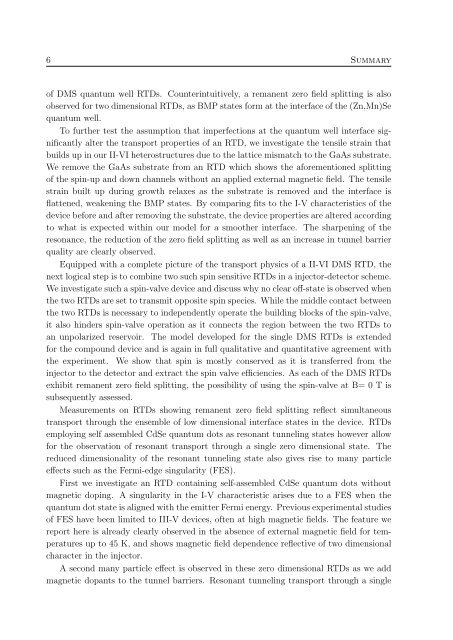A Comprehensive Study of Dilute Magnetic ... - OPUS Würzburg
A Comprehensive Study of Dilute Magnetic ... - OPUS Würzburg
A Comprehensive Study of Dilute Magnetic ... - OPUS Würzburg
You also want an ePaper? Increase the reach of your titles
YUMPU automatically turns print PDFs into web optimized ePapers that Google loves.
6 Summary<br />
<strong>of</strong> DMS quantum well RTDs. Counterintuitively, a remanent zero field splitting is also<br />
observed for two dimensional RTDs, as BMP states form at the interface <strong>of</strong> the (Zn,Mn)Se<br />
quantum well.<br />
To further test the assumption that imperfections at the quantum well interface significantly<br />
alter the transport properties <strong>of</strong> an RTD, we investigate the tensile strain that<br />
builds up in our II-VI heterostructures due to the lattice mismatch to the GaAs substrate.<br />
We remove the GaAs substrate from an RTD which shows the aforementioned splitting<br />
<strong>of</strong> the spin-up and down channels without an applied external magnetic field. The tensile<br />
strain built up during growth relaxes as the substrate is removed and the interface is<br />
flattened, weakening the BMP states. By comparing fits to the I-V characteristics <strong>of</strong> the<br />
device before and after removing the substrate, the device properties are altered according<br />
to what is expected within our model for a smoother interface. The sharpening <strong>of</strong> the<br />
resonance, the reduction <strong>of</strong> the zero field splitting as well as an increase in tunnel barrier<br />
quality are clearly observed.<br />
Equipped with a complete picture <strong>of</strong> the transport physics <strong>of</strong> a II-VI DMS RTD, the<br />
next logical step is to combine two such spin sensitive RTDs in a injector-detector scheme.<br />
We investigate such a spin-valve device and discuss why no clear <strong>of</strong>f-state is observed when<br />
the two RTDs are set to transmit opposite spin species. While the middle contact between<br />
the two RTDs is necessary to independently operate the building blocks <strong>of</strong> the spin-valve,<br />
it also hinders spin-valve operation as it connects the region between the two RTDs to<br />
an unpolarized reservoir. The model developed for the single DMS RTDs is extended<br />
for the compound device and is again in full qualitative and quantitative agreement with<br />
the experiment. We show that spin is mostly conserved as it is transferred from the<br />
injector to the detector and extract the spin valve efficiencies. As each <strong>of</strong> the DMS RTDs<br />
exhibit remanent zero field splitting, the possibility <strong>of</strong> using the spin-valve at B= 0 T is<br />
subsequently assessed.<br />
Measurements on RTDs showing remanent zero field splitting reflect simultaneous<br />
transport through the ensemble <strong>of</strong> low dimensional interface states in the device. RTDs<br />
employing self assembled CdSe quantum dots as resonant tunneling states however allow<br />
for the observation <strong>of</strong> resonant transport through a single zero dimensional state. The<br />
reduced dimensionality <strong>of</strong> the resonant tunneling state also gives rise to many particle<br />
effects such as the Fermi-edge singularity (FES).<br />
First we investigate an RTD containing self-assembled CdSe quantum dots without<br />
magnetic doping. A singularity in the I-V characteristic arises due to a FES when the<br />
quantum dot state is aligned with the emitter Fermi energy. Previous experimental studies<br />
<strong>of</strong> FES have been limited to III-V devices, <strong>of</strong>ten at high magnetic fields. The feature we<br />
report here is already clearly observed in the absence <strong>of</strong> external magnetic field for temperatures<br />
up to 45 K, and shows magnetic field dependence reflective <strong>of</strong> two dimensional<br />
character in the injector.<br />
A second many particle effect is observed in these zero dimensional RTDs as we add<br />
magnetic dopants to the tunnel barriers. Resonant tunneling transport through a single
















